The project of self-propelled artillery Geschützwagen Tiger (Germany)
A promising project was launched in May 1942. Krupp was given the task of developing a promising self-propelled gun with heavy weapons. To simplify the work and maximize unification of the new equipment with the existing one, it was proposed to build a new self-propelled guns based on one of the existing or under development heavy tanks. In addition, it was planned to use the existing large-caliber gun. It was assumed that the new combat vehicle could significantly increase the mobility of heavy artillery. Due to its own chassis and some transportable ammunition, it could be advanced to predetermined positions and open fire much earlier than similar systems in the towed version.
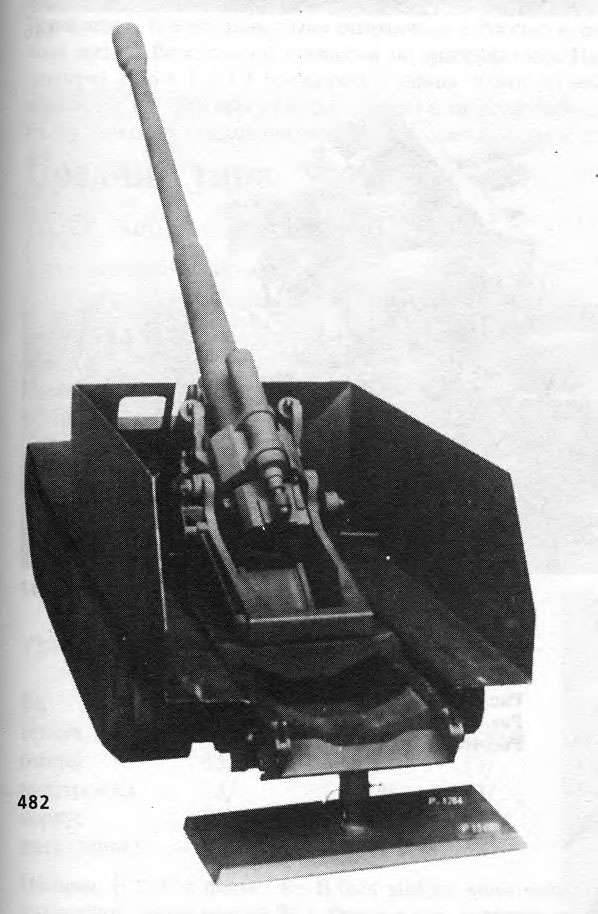
SAU model Geschützwagen Tiger with a raised gun. Photo of Chamberlain P., Doyle H. "Complete reference book of German tanks and self-propelled guns of the Second World War"
By the beginning of 1943, various preliminary works were carried out, based on the results of which a preliminary appearance of the new ACS was formed, and its main components were identified. In addition, by this time the project received the designation Geschützwagen Tiger ("Self-propelled carriage based on the tank" Tiger "). It was proposed to build a combat vehicle on the basis of a special chassis, the basis for which should be the units of one of the newest tanks. We chose a heavy tank as a base for such a chassis, which was later put into service under the designation Pz.Kpfw.VI Ausf.B. Also, this machine is known under the unofficial designation Tiger II. It was proposed to borrow a number of components and assemblies, as well as to alter the design of the original machine in accordance with the new requirements.
The prospective ACS, according to customer requirements, was to receive an 170 mm caliber gun, which placed particular demands on the chassis. It should have the appropriate dimensions, carrying capacity and strength. In its current form, the chassis of the Tiger II tank did not meet such requirements, which led to its most serious processing. Moreover, the volume of introduced innovations and changes allows to consider this chassis as a completely new armored vehicle or, at least, a deep modernization of the tank.

Layout shows the process of unloading tools. Photo of Chamberlain P., Doyle H. "Complete reference book of German tanks and self-propelled guns of the Second World War"
To accommodate the required large and heavy weapons had to develop a completely new armored body of the appropriate layout. For optimal placement of all units, first of all guns, the power unit and transmission had to be placed in the front half of the hull, moving the engine to the center of the car. Next to the units of the power plant, it was necessary to place the control compartment, and the aft part of the hull, a little more than half of the total length, was given under the armored cabin with the fighting compartment. This arrangement has already been used in some projects of ACS of German and foreign development and has shown itself well.
Initially it was assumed that the Geschützwagen Tiger ACS would fire at enemy positions from long distances, up to km 20-25. Because of this, the car did not need a serious booking. However, for several reasons, it was decided to manufacture the body of the self-propelled gun of relatively thick armor plates that can protect the crew not only from bullets, but also from some artillery shells. The front hull and roof sheets had a thickness of 60 mm, and were also installed at different angles. The hull roof should be made of 40-mm armor, and the bottom could have a thickness of 25 mm. Thus, the level of protection promising self-propelled gun could not yield to a number of medium tanks of the time.
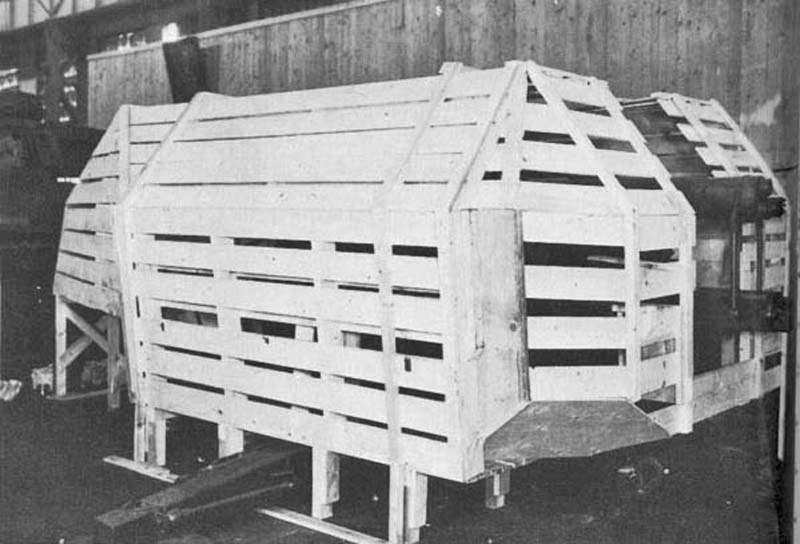
Full size wooden layout of the fighting compartment, view from the outside. Photo Aviarmor.net
The chassis body had to have an inclined upper frontal sheet and a horizontal roof, with which the inclined frontal part of the cabin was connected. The forehead and sides of the cabin fell at a small angle inwards, to a certain extent increasing the level of crew protection. The roof and the rear wall of the logging were not envisaged in view of some of the original proposals concerning the use of ACS.
The power plant for self-propelled guns was built on the basis of the aggregates of the heavy tank being developed at that time. From Panzerkampfwagen VI Ausf.B, the Geschützwagen Tiger was supposed to inherit the Maybach HL 230 P30 petrol engine with a power of 700 hp. and mechanical transmission, which included a set of different units. With the help of a multi-disc main clutch integrated into the eight-speed gearbox, the planetary turning mechanism and the onboard gears, the engine torque was to flow to the front drive wheels.
The undercarriage of the base tank had nine support rollers of chess arrangement on each side. In view of the overall increase in the size of the structure, the Geschützwagen Tiger project provided for the use of two additional pairs of rollers. The first additional pair was to be located immediately behind the drive wheel and be at some distance from the next rollers. The second additional pair was placed behind the main group of road wheels and in front of the guide wheel. At the same time, the rear roller was located at some distance from the others and did not overlap with them. As elastic elements of the suspension provided torsion bars.
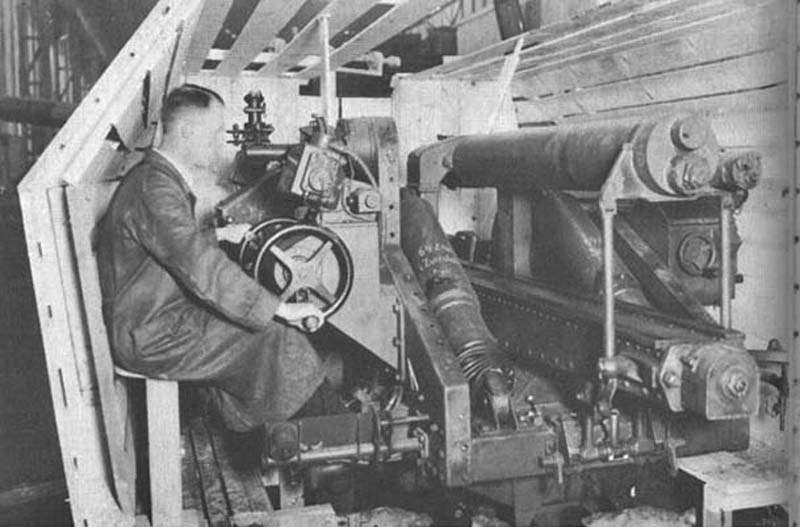
Layout chopping, view inside. Photo Aviarmor.net
The crew of the prospective ACS was to consist of eight people. The places of the driver and the radio operator were located at the front of the hull, in the control room. The commander, gunner, loader and three carriers had to be located and work in the wheelhouse.
As the main weapons for the new self-propelled gun in the original project was proposed gun 17 cm Kanone 72 caliber 170 mm, which is a modified version of the towed 17 cm Kanone 18. When developing a new instrument based on an existing one, it was proposed to use updated systems of installation and guidance. In addition, the trunk should have a new muzzle brake, significantly reducing the impact force on the base chassis. The rest of the gun almost did not differ from the original gun.
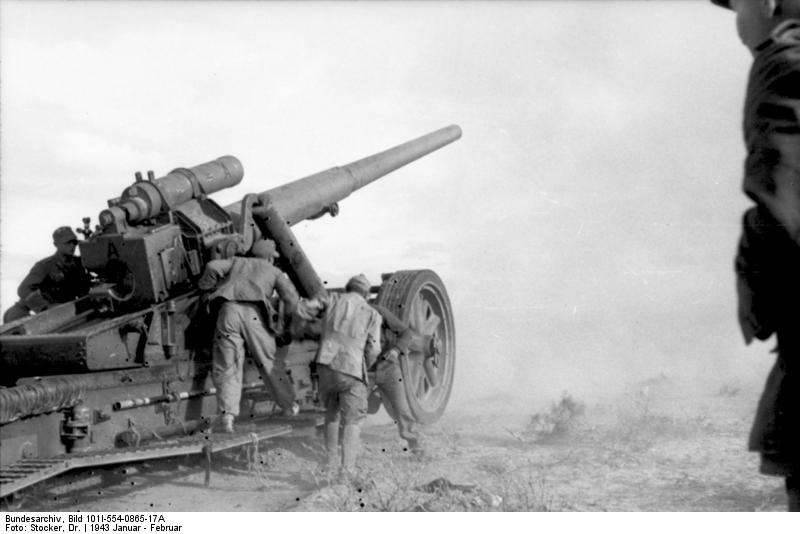
17 cannon Kanone 18 gun on a towed carriage. Photo of Wikimedia Commons
17 cm Kanone 72, having a barrel length 50 caliber, depending on the method of installation, could fire at a rate of up to a minute 1-2 rounds and accelerate projectiles of various types weighing up to 71 kg up to speed 925 m / s. The maximum firing range was determined at the level of 29,6 km. The design of the base towed carriage used with the Kanone 18 gun allowed the barrel to be raised from -6 ° to + 50 °. The angles of horizontal pick-up depended on the method of using the gun: when firing from a wheel course, the firing sector was limited to 16 °. Lowering the gun on the base plate, you could shoot in any direction.
According to reports, the Geschützwagen Tiger project considered two options for installing guns. The first implied installation in the cabin of a fixed installation with attachments for the gun. In this case, a typical ACS was obtained with the possibility of vertical guidance within a significant sector and horizontal guidance by turning the entire body and fine-tuning the existing mechanisms. To ensure a stable position of the self-propelled gun at the time of shooting, it was proposed to use an outrigger plate located in the rear of the vehicle and transmitting a recoil impulse to the ground.
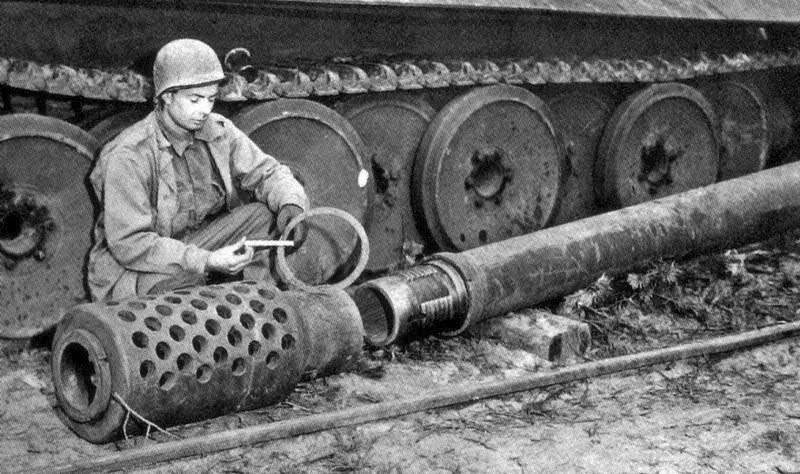
An American soldier inspects the muzzle brake of an 17 cm Kanone 72 gun. Photo Aviarmor.net
The second project of placing weapons meant the use of a special mast, based on the existing design with a wheel travel. Such a carriage was proposed to be mounted movably in the fighting compartment. Its design allowed the crew of self-propelled guns to fire without leaving the car. In addition, it was possible to remove the gun from the chassis and use it as a conventional field gun. For this it was proposed to lower the plate outrigger and remove the carriage from the stoppers. Next, the self-propelled gun was supposed to move forward, withdrawing from the crew compartment gun carriage. Then it was proposed to lower the carriage base plate, after which the car could drive off, and the gun would fall to the ground and be able to fire without any restrictions on horizontal laying.
The 17 cm Kanone 72 cannon, like the base Kanone 18, should have used relatively large and heavy split-loading shots. So, the weight of the shells reached 71 kg (armor-piercing 17 cm Pz.Gr.43), and the maximum projectile charge weighed more than 30 kg. The large size and weight of the projectile led to the introduction of several gun munitions into the calculation of the gun. In addition, they caused a sharp reduction in ammunition. Despite the large size of the fighting compartment, it was possible to place no more than 5-10 shells in it. For a longer shooting new self-propelled guns required a separate carrier of ammunition.
SAU Geschützwagen Tiger was supposed to work at a distance from the front edge, but still received weapons for self-defense. In the front of the hull provided for the installation of the machine gun MG 34. According to some reports, another such machine gun could be transported in the styling of the fighting compartment. However, he did not have his own installation and therefore could be used for firing in any direction.
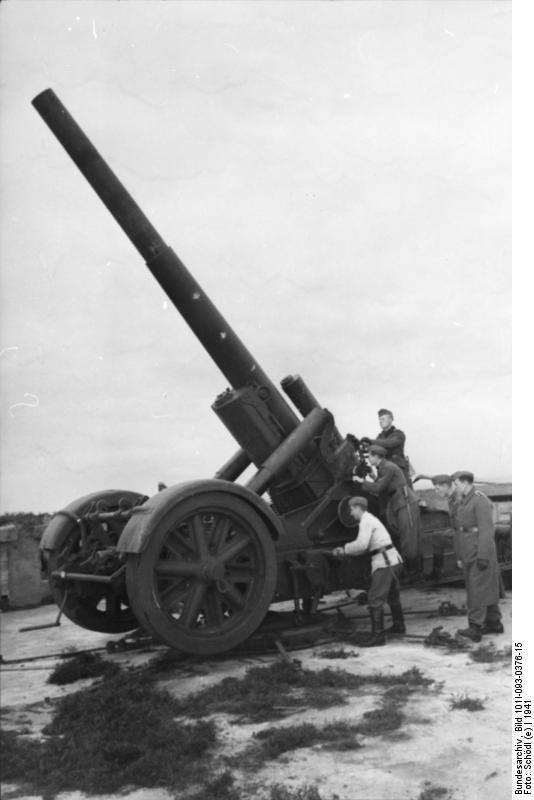
Howitzer 21 cm Mörser 18 - an alternative weapon self-propelled guns. Photo of Wikimedia Commons
At a certain stage of the development of the draft new SAU, it was proposed to consider the possibility of using new weapons. An alternative to the Kanone 72 gun was to be a howitzer (mortar) 21 cm Mörser 18 caliber 210 mm. In the original towed form, such a weapon could fire with elevation angles from -6 ° to + 70 °. Due to the similarity of design, the angles of the horizontal guide carriage were the same as those of the 17 cm Kanone 18. With the help of a barrel of 30 length, a howitzer could accelerate 113-kg high-explosive fragmentation projectile up to speed 550 m / s. The maximum firing range was 14,5 km.
For the installation of a 21 mortar cm Mörser 18 inside an ACS chopping house, existing units designed for 170-mm guns were proposed. In this case there were some differences related to the difference in the design and size of the two guns. According to some reports, the 210-mm howitzer could also be unloaded from the tracked chassis and used as a field gun.
There are reports of attempts to develop a new weapon system for the Geschützwagen Tiger. In case of their successful completion, the armored vehicle could become a carrier of 305 and 420 mm mortars. However, in view of the total complexity and other problems, these proposals did not go beyond the preliminary study stage. Possibly, the fate of such proposals was affected by the excessive power of the guns, which could damage the design of the base chassis. Thus, with some dubious advantages, the Geschützwagen Tiger ACS with 305 or 420-mm mortars should have serious drawbacks.
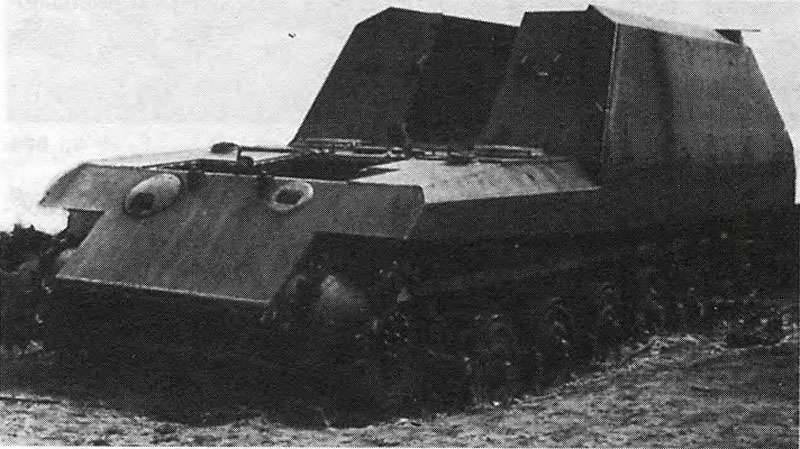
Unfinished prototype, which became the trophy of the allies. Photo of Chamberlain P., Doyle H. "Complete reference book of German tanks and self-propelled guns of the Second World War"
Due to the use of a large-caliber cannon with an appropriate installation, the self-propelled gun of the new type was large and heavy. Its total length, taking into account the 170-mm gun barrel, reached 13 m, and the width and height were to exceed 3 m. The combat weight was determined at the level of 60 t.
The main design work on the perspective ACS was completed in 1944, shortly after which the mockup assembly started. It is known to manufacture a scale model of a Geschützwagen Tiger self-propelled gun with a 17 cannon Kanone 72 cannon and a removable gun carriage, which allowed the gun to be removed from the chassis. Probably, this product was used to demonstrate the new development of the army command and the leadership of the country.
Later a full-scale model of the combat compartment was made. He received a wooden structure, imitating the wheelhouse, and mechanisms mechanisms with all the necessary equipment. On this model, the ergonomics of the self-propelled guns and the ease of use of the gun were tested.
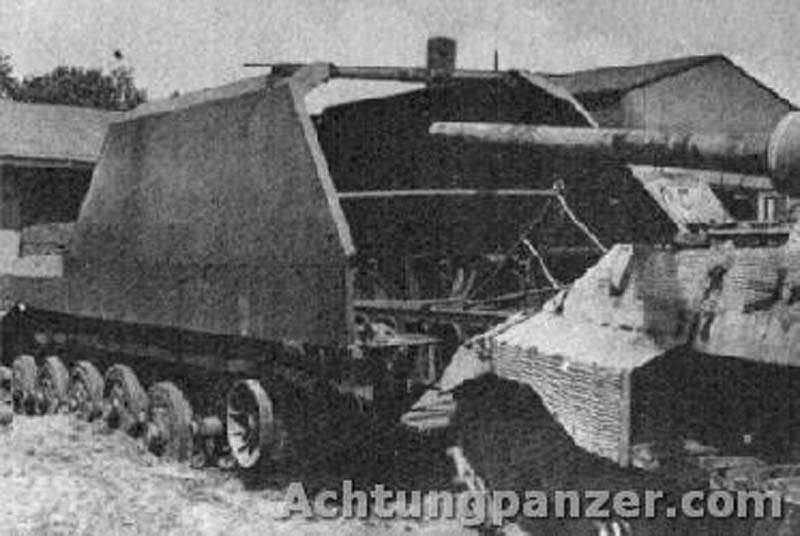
Prototype, rear view. Photo by Achtungpanzer.com
According to the results of checks of models and other similar works, the command decided to build the first self-propelled prototype. The construction of a promising chassis began at the Krupp plant, which later was to receive a new gun. Due to the workload of other orders, problems with the supply of necessary components and other factors characteristic of the final stage of the Second World War, the assembly of the experienced self-propelled gun Geschützwagen Tiger proceeded extremely slowly.
By February, 1945, the German specialists were able to assemble a hull with a wheelhouse, and, according to some sources, to equip it with an engine and transmission. In addition, chassis assemblies were mounted. As follows from the available data, preparations began for the installation of the installation with an 170 caliber mm gun.
However, the construction of an experimental self-propelled gun was not completed. In February, 1945, the German command decided to close a number of projects in order to release resources and forces for the implementation of other programs. To concentrate forces on more priority projects, it was decided to abandon a number of developments, including the ACS Geschützwagen Tiger. The only prototype remained uncompleted with an incomplete set of assemblies and units, as well as without weapons.
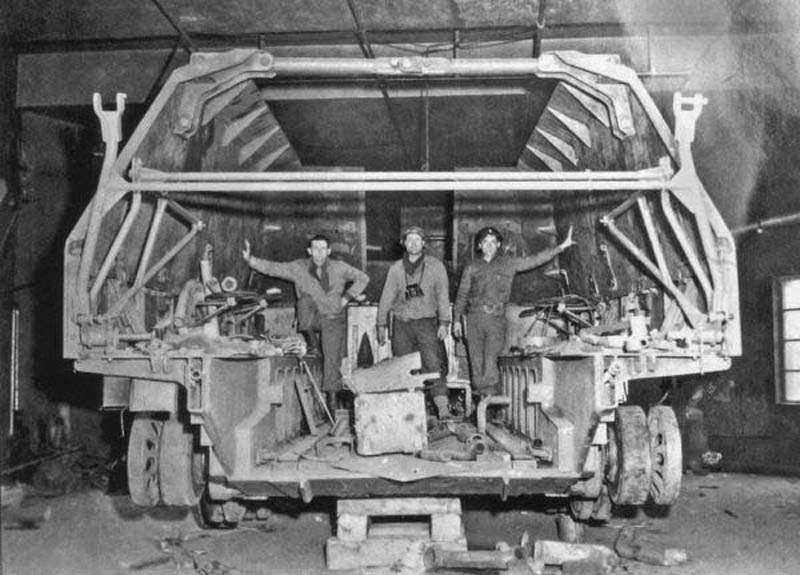
Snapshot with a trophy. You can estimate the size of the cabin. Photo Aviarmor.net
In the last weeks of the war, the Allied forces, who continued the offensive on all fronts, captured a number of large enterprises, including the plant on which the Geschützwagen Tiger prototype was built. American (according to other sources, British) soldiers took the unfinished car as one of the many trophies. In the future, the specialists studied the prototype and the found documentation on it, but probably did not show much interest.
After studying the project, it was decided not to finish building and not to test the new German self-propelled gun. Documentation on it was sent to the archive, and the unfinished prototype was disassembled and sent to the smelter, since it was of no interest for further work. Thus, by the three-year anniversary of the project, all work was stopped, and the only not fully assembled prototype ceased to exist.
With all its positive qualities, the promising project of the Geschützwagen Tiger self-propelled gun was not without its drawbacks. The main of them, which had the most significant negative impact, can be considered a relatively late start of development. This factor, combined with the complexity of the project, led to the fact that by the end of the war the German industry did not have time to complete even one prototype of a promising combat vehicle. Perhaps, under a different set of circumstances, the Geschützwagen Tiger ACS could have been put to the test or even went into series, but in practice, the difficulties did not allow the project developers to achieve such success.
Based on:
http://achtungpanzer.com/
http://aviarmor.net/
http://ww2history.ru/
http://militaryfactory.com/
Chamberlain P., Doyle H. Complete reference book of German tanks and self-propelled guns of the Second World War. - M .: AST: Astrel, 2008.
Information